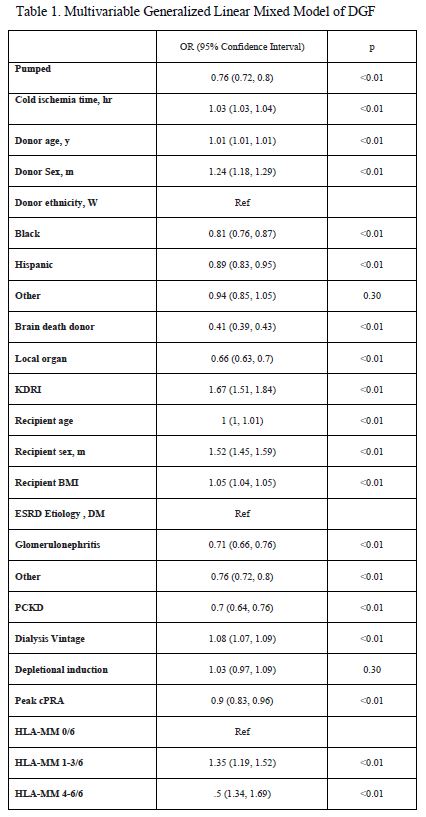Predictors of delayed graft function in the United States: A comprehensive multivariable analysis with a focus on hypothermic machine perfusion
Ahmed Zeen Alabedeen Alrifai1, Mohammed Y Mahgoub1, Amanda L Tapia3, Byron H Smith3, Issa S Naim1, Hatem Amer1, Patrick G Dean2, Samy Riad1.
1Nephrology and Hypertension, Mayo Clinic, Rochester, MN, United States; 2Transplantation Surgery, Mayo Clinic, Rochester, MN, United States; 3Clinical Trials and Biostatistics, Mayo Clinic, Rochester, MN, United States
Background: Delayed graft function (DGF) has been associated with adverse short and long-term outcomes. Identifying modifiable risk factors is crucial for prevention. This study investigates the predictors of delayed graft function, with a specific emphasis on hypothermic machine perfusion.
Methods: Using data from the Scientific Registry of Transplant Recipients (SRTR), we examined all dialysis-dependent primary deceased donor kidney transplant recipients transplanted from 2014 to 2022. All transplants were blood group compatible and crossmatch negative. Recipients received standard induction and were discharged on tacrolimus and mycophenolate with or without steroids. Recipients were categorized into two groups based on kidney hypothermic machine perfusion usage: the pumped and static storage groups. Pretransplant variables and posttransplant outcomes were compared between the two groups using χ2 or Wilcoxon tests as appropriate. A multivariable generalized linear mixed model, adjusting for relevant donor and recipient characteristics, with organ procurement organization (OPO) included as random effects, was employed to examine the association between hypothermic machine perfusion and delayed graft function.
Results: The analysis included 52,982 deceased donor kidney recipients, with 26,246 recipients in the pumped group and 26,376 in the static storage group. The utilization of machine perfusion has slightly increased in the last three years.

Kidneys from circulatory death donors were more likely to be in the pumped group (11.7% vs. 38.4%, p < 0.001). The average donor age was 4.9 years older (p < 0.01), and the recipient cold ischemia time was, on average, 5.5 hours longer (p < 0.001) in the pumped group. Hypothermic machine perfusion was associated with a 24% lower odds of delayed graft function [OR 0.76, 95% C.I. (0.72, 0.80, p < 0.01)]. Longer cold ischemia time was associated with a 3% per hour increased odds of delayed graft function [OR 1.03, 95% C.I. (1.03, 1.04), p < 0.01]. Depletion induction was not a predictor of delayed graft function.

Conclusion: In this extensive cohort of deceased donor kidney recipients, hypothermic machine perfusion, cold ischemia time, and recipient BMI emerged as robust predictors of delayed graft function, offering modifiable factors to reduce the odds of potential DGF.
The data reported here have been supplied by the Hennepin Healthcare Research Institute (HHRI) as the contractor for the Scientific Registry of Transplant Recipients (SRTR). The interpretation and reporting of these data are the responsibility of the authors and in no way should be seen as an official policy of or interpretation by the SRTR or the U.S. Government..
[1] machine perfusion
[2] delayed graft function
[3] kidney transplantation
